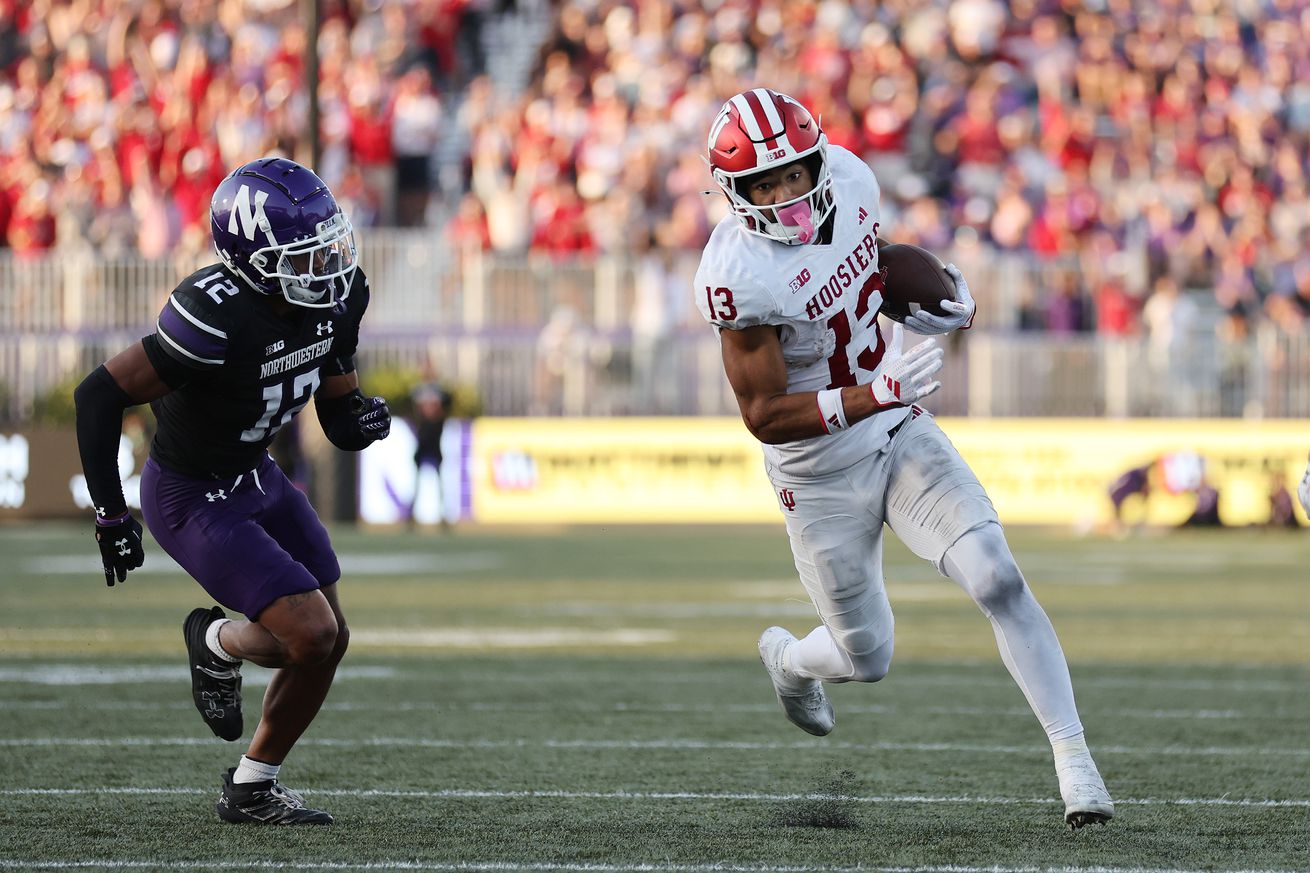
The run-pass option continues to slice the Wildcats.
Note: To optimally view the visualizations used below, access this article on a computer.
After being the knot holding Northwestern together through four games, the Wildcats’ defense finally collapsed.
“Some miscommunications along the way, some poor tackling along the way,” coach David Braun said after Northwestern’s 41-24 loss against Indiana. “We talked about finding ways to disrupt the quarterback, and we weren’t able to do that.”
It wasn’t a wrecking ball-style knockdown, rather a systematic network of chunk plays the Hoosiers’ offense detonated via the run-pass option game to dismantle Northwestern’s defense. A unit that allowed 302 yards per game prior to Week 6 imploded, surrendering 529 yards to Indiana’s Big Ten-leading attack.
Indiana’s offense pummeled the Wildcats all afternoon, ending the day with the fourth most yards Northwestern has allowed since 2018,. Kurtis Rourke finished 25-of-33, throwing for 380 yards and three touchdowns en route to leading Indiana to score in all seven of its trips to the red zone.
On the ground, Indiana’s offensive line pushed the Wildcats back all afternoon. Northwestern gave up 149 rushing yards, the most the Wildcats’ defense has allowed all season long.
The Hoosiers’ rushing success was piece one to unraveling Tim McGarigle’s unit. Piece two: Indiana’s RPO game that killed Northwestern’s soft man coverage scheme. With the deadly combination of space at the line of scrimmage for Indiana’s receivers and Northwestern’s linebackers being forced to bite on the run fake, Rourke’s arm gunned past Northwestern’s young secondary.
Elijah Sarratt was NU’s main problem. Racking up seven catches for 135 yards, including 56 after the catch, the 6-foot-2, 209 pound James Madison transfer exposed the weakest part of Northwestern’s defense. Starting defensive back Theran Johnson was the only bright spot, totaling a career-high three pass break ups.
The explosive plays were the real issue, especially through the air. Northwestern allowed 15 big plays (defined as passing plays of 15-plus yards and rushing plays of 10-plus yards) against the Hoosiers, 10 of which came in the passing game.
Sitting in the top right of the graph, you can see that Northwestern’s giving up the second-most chunk passing plays per game, dropping the ‘Cats to 15th in the Big Ten and 112th in the country in passing yards allowed per game.
Northwestern entered Week 6 having allowed 41 passes of 10-plus yards, counting seven passing plays of at least 20 yards. Against the Hoosiers’ aerial attack alone, Northwestern gave up 17 passes of 10-plus yards, including eight 20-plus yard passing plays.
Northwestern’s 380 passing yards allowed against Indiana were the most since conceding 423 passing yards to Purdue in 2021. That doesn’t bode well ahead of a Friday night matchup with Maryland.
The Terrapins’ offense boasts the second best passing attack in the Big Ten (behind Indiana) and 12th best offense in the nation in passing yards per game. Quarterback Billy Edwards Jr. has been phenomenal taking over for Taulia Tagovailoa, throwing for 1,444 yards on 72.3% accuracy alongside 11 touchdowns and two interceptions through five games this season.
Wideout Tai Felton is the real problem though. The only receiver in the conference to average over 100 yards per game, Felton’s 46 receptions and 642 receiving yards rank first in the Big Ten alongside his five receiving touchdowns. He’s also played well against Northwestern before, catching four passes for 44 yards and a touchdown at Ryan Field last season.
With Ore Adeyi’s injury and the bevy of defensive back changes this offseason after Garnett Hollis Jr., Jaheem Joseph and Rod Heard II’s departures, Northwestern’s pass defense was expected to struggle. As the ‘Cats continue to develop young defensive backs Evan Smith and Josh Fussell alongside Johnson, Northwestern needs improvement from its secondary if it wants to be competitive in conference play — which it showed it could be against Indiana.
Yet by playing a slew of soft man, it leaves the Wildcats susceptible to the RPO game that flamed them against Duke and last week against the Hoosiers. It’s clearly Northwestern’s defensive philosophy, but by putting pressure on the linebackers, while giving dangerous receivers extra cushion at the line of scrimmage, it relies too heavily on an inexperienced secondary to make plays in the open field.
What seems increasingly likely is Northwestern is giving receivers cushion because it doesn’t trust its young defensive backs to keep up at the line of scrimmage. After all, Washington’s Denzel Boston blazed past the Wildcats’ secondary in Seattle for seven catches, 121 yards and two touchdowns, including a 46-yard score from Will Rogers that flew over the top of Northwestern’s defense.
If the ‘Cats can’t stop the intermediate passing game out of fear of getting flamed over the top, it seems like Indiana’s heavy RPO usage might just be the recipe teams use to bombard Northwestern’s defense.
Here’s where Northwestern ranks nationally after Week 6:



